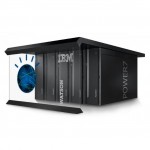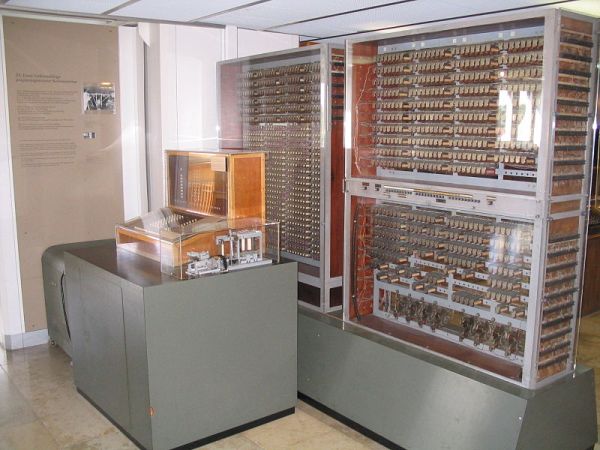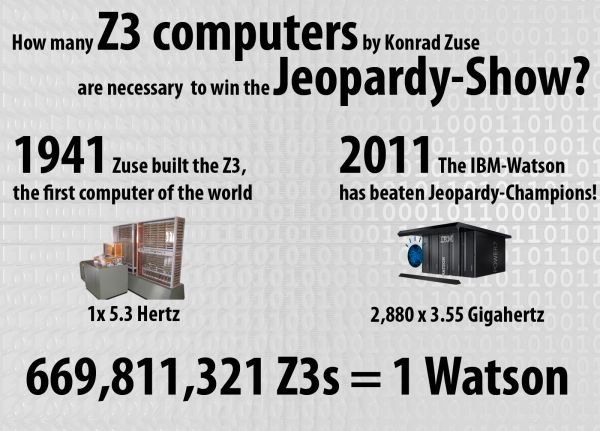70 Years of Computing – The Z3 versus Watson
 We recently reached a new milestone in computer science when Watson, IBM’s latest super computer, competed against Jeopardy’s world champions and won. Watson was made up of 90 networked servers, each with a 3.5GHz Eight-core CPU, each core capable of processing 4 threads at once. Compared to a conventional computer, that’s like 2,880 CPUs! Watson also had 15TB (15,000GB) of RAM.
We recently reached a new milestone in computer science when Watson, IBM’s latest super computer, competed against Jeopardy’s world champions and won. Watson was made up of 90 networked servers, each with a 3.5GHz Eight-core CPU, each core capable of processing 4 threads at once. Compared to a conventional computer, that’s like 2,880 CPUs! Watson also had 15TB (15,000GB) of RAM.
You may think that the human contestants stood no chance against even a normal computer, but the trick is getting a machine to understand human language. That’s why Watson has so much power; it all goes towards translating the question and deciphering the answer from a few Terabytes of data (Watson was not allowed to access the internet).
Back on May 12th, 1941, German engineer Konrad Zuse introduced the Z3, the very first programmable computer. In honor of the 70th birthday of the world’s first computer, we posed the question: could it be possible to build Watson back in 1941?
About the Z3

Konrad Zuse started development in 1935, in his parents’ living room, and after two previous attempts, he finally made it, the Zuse 3, known today as the Z3. Konrad Zuse became a pioneer of computer science. He invented the binary system, the foundation of just about every computer in existence. Although he didn’t use the term “computer,” it is what we would call it today. The Z3 weighed just over a ton (about as much as a small car) and had a working memory of just 200 bytes. When operating at full capacity Zuse 3 needed 4000 Watts of electricity, despite only having a 5.3 Hertz processor.
The Z3 versus the year 2011

In the year 2011 IBM computer Watson has beaten the best Jeopardy players of the World. What would happen if the Z3 takes the part of Watson? How many Z3 are needed to match Watson, the most powerful computer of 2011? Watson has the equivalent of 2,880 3.55 Gigahertz central processors and 15 Terabytes of memory. Just to match the raw frequency of Watson, we would need 669,811,321 Z3 computers networked together (assuming zero processing overhead of the network interface). A single Z3 needs 4000 Watts of power, so all 670 million together would need 2,679,245 Megawatts. That’s approximately 17% of the entire world’s power. To produce that amount of electricity mankind would need 452,576 atomic power plants, such as the one in Winterburg, Arizona. Currently, Germany has 17 active nuclear power plants. World-wide are only 443 atomic power plants in use. All of the world’s atomic power alone isn’t enough to let the Z3 play Jeopardy.

If we wanted to be a bit more eco-friendly, there’s also the option of wind energy plants. With the average output of 1.26 Megawatts per plant, it would take 2,126,385 wind energy plants to produce enough power for the 670 million Z3 computers. Today, approximately 194,400 Megawatts are produced by wind energy, nowhere near enough for the Z3 super cluster.
All of that is just to match Watson’s processing power. The Z3 only had 200 bytes of memory, so it would take 7.5 billion Z3 computers to match Watson’s impressive 15 Terabytes of RAM. To power all of that, it would take twice as much power as the world is currently capable of producing.
Conclusion
Thanks to Konrad Zuse for truly bringing us into the computer age, but it seems that, at least for now, energy constraints make it impossible for the Z3 to win a game of Jeopardy. Still, it’s a tribute to the progress we’ve made thanks to the brilliance of Konrad Zuse.

